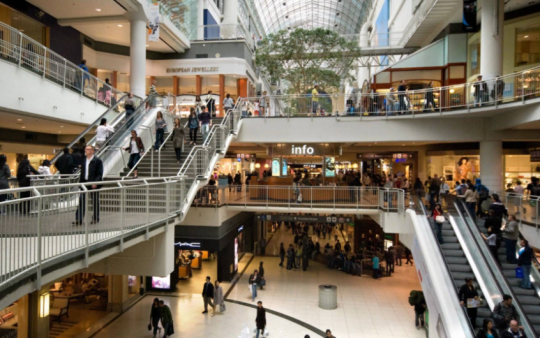
The decline of American mall traffic, particularly
in its anchor stores, has been perhaps the biggest indicator of changes in
shopper preferences. When Morning
Consult asked U.S. shoppers what features would make visiting shopping
malls more enticing, most said cheaper retail prices (73%); more and improved food options (58%); and renovated movie theaters (51%).
A separate Morning Consult poll revealed that a majority (54%) of Americans shop at the mall less
often than they did five years ago, and 59%
don’t think malls will be popular shopping destinations 10 years from now.
The RTP team
shares whether the Morning Consult polls align with their own mall shopping
experiences, and what malls (and the retailers within them) can do to stay
relevant.
Debbie Hauss,
Editor-in-Chief: Just like standalone brick-and-mortar
stores, malls need to pivot and become more experiential and local.
Mall operators must consider the surrounding community: plan events that engage
nearby families and businesses. Get involved with local school districts and
charities. Malls are no longer the draw they were when they first
introduced in the 1950s. One of the fastest-growing mall segments is the
Eat-Work-Live environment, where homes and businesses and built nearby or
intermixed with the shopping district. Stores and restaurants are
planned based on the type of homeowner and businesses moving into the space.
This approach offers a greater guarantee of success for the retail
businesses.
Adam Blair, Executive
Editor: Obviously there’s no one “silver bullet” that will
resurrect malls to their once-proud place at the forefront of
American retail, but this poll does offer some constructive suggestions. More
than half (58%) of respondents identified “more and improved food
options” as something that would make malls more enticing. I agree
that it would be nice to be surprised by the offerings at a mall food court,
and not see just the same old variations on Taco Bell/Panda Express/Cinnabon,
etc. How about some fresh local cuisine, reminding the shopper that they are in
a specific geographic place and not in an anonymous Anymall, U.S.A.? How about
hosting a farmer’s market one Saturday a month? Beyond that, this A.T. Kearney report has a number of provocative ideas
about how malls can once again make themselves relevant in a changed
retail landscape.
Marie Griffin,
Managing Editor: Today, shopping is an always-on activity that
can be done while dinner is cooking, while watching TV or while rushing to or
from work. Shopping is no longer a special event, and retailers and
mall developers must adjust to this new reality. The idea of “shopping” as an
anchor for a destination mall no longer makes sense. No wonder the consumers
responding to the Morning Consult survey say they want better dining and movie
theater options in malls; going out to eat and going to the movies are
still activities worth getting off the couch to do. If retailers embrace the
idea that shopping is done around other activities,
and put pressure on mall developers to build multifaceted attractions — Mall of
America is the ultimate model of this — retailers will reap the benefits.
Within an environment filled with energized, engaged consumers, stores have the
best opportunity to leverage their strengths.
Klaudia Tirico,
Features Editor: I may be one of very few people who still believe
in malls, but that’s because I live five minutes away from what I think is
one of the top malls in New Jersey: Westfield Garden State Plaza
(GSP) in Paramus. I can honestly say the Morning Consult survey results don’t
really align with my experience at the malls I frequent, especially
GSP (besides the fact that malls are crowded, but doesn’t that mean
they’re doing something right?). The mall houses a variety of top-notch
retailers, from the usual suspects like Hollister and Macy’s
to luxury stores such as Tiffany & Co., Gucci and Tory
Burch. It is even home to unique retailers that you won’t normally find in
New Jersey malls, such as Danish variety store Flying Tiger,
Sugarfina and Amazon Books. The food options are awesome (Shake
Shack, Bar Louie, The Capital Grille) and there is an AMC move theater. It’s
extremely clean and luxurious, with a ton of high-tech parking. Aside from
that, it provides consumers with unique experiences. Most recently, GSP hosted an exhibit called Up Close:
Michelangelo’s Sistine Chapel, which also offered Italian language
lessons. With all that said, I truly believe malls have so much potential
to cater to a new generation of consumers and stay relevant in the industry.
They just have to evolve with the times and consumer demands — much like The
Garden State Plaza has.
Glenn Taylor, Senior
Editor: I do find it funny that the top word associated with malls is still “crowded” at 55%. When I shop at malls during non-holidays, I don’t feel like
the crowds are that overwhelming. Even if the experience itself is
underwhelming, the number of people in the mall never seems to be a major issue
preventing me from having a good experience. Instead, it’s often the wild goose
chase of having to figure out where everything is and how to find it —
so I guess the low 44% calling it “convenient” may be on to something
there. Last summer, I had an informative chat with Jason
Green, CEO of The Cambridge Group, about the future of malls. Green echoed
many of the sentiments others have shared
regarding the need to create a “lifestyle mix” within malls focused on
entertainment, even incorporating apartment buildings and condos. But I think
he made a great point about mobile that needs to be considered more when
reevaluating mall space. To boost convenience, retailers and mall operators can
push out messages such as: “While you go enjoy a movie or concert, you have
a click-and-collect opportunity where you don’t have to wade through the store.
You could just go to the front and pick it up.”






